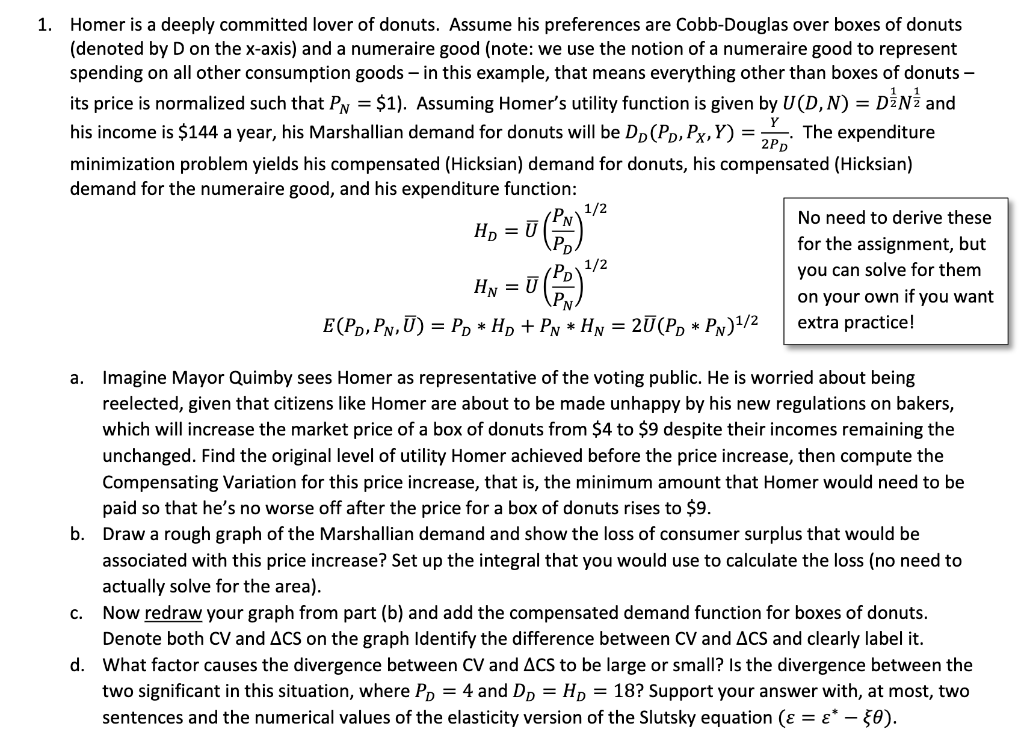
Homer is a deeply committed lover of donuts. Assume his preferences are Cobb-Douglas over boxes of donuts (denoted by D on the x-axis) and a numeraire good (note: we use the notion of a numeraire good to represent spending on all other consumption goods - in this example, that means everything other than boxes of donuts its price is normalized such that PN=$1). Assuming Homer's utility function is given by U(D,N)=D21N21 and his income is \$144 a year, his Marshallian demand for donuts will be DD(PD,PX,Y)=2PDY. The expenditure minimization problem yields his compensated (Hicksian) demand for donuts, his compensated (Hicksian) demand for the numeraire good, and his expenditure function: a. Imagine Mayor Quimby sees Homer as representative of the voting public. He is worried about being reelected, given that citizens like Homer are about to be made unhappy by his new regulations on bakers, which will increase the market price of a box of donuts from $4 to $9 despite their incomes remaining the unchanged. Find the original level of utility Homer achieved before the price increase, then compute the Compensating Variation for this price increase, that is, the minimum amount that Homer would need to be paid so that he's no worse off after the price for a box of donuts rises to $9. b. Draw a rough graph of the Marshallian demand and show the loss of consumer surplus that would be associated with this price increase? Set up the integral that you would use to calculate the loss (no need to actually solve for the area). c. Now redraw your graph from part (b) and add the compensated demand function for boxes of donuts. Denote both CV and CS on the graph Identify the difference between CV and CS and clearly label it. d. What factor causes the divergence between CV and CS to be large or small? Is the divergence between the two significant in this situation, where PD=4 and DD=HD=18 ? Support your answer with, at most, two sentences and the numerical values of the elasticity version of the Slutsky equation (=). Homer is a deeply committed lover of donuts. Assume his preferences are Cobb-Douglas over boxes of donuts (denoted by D on the x-axis) and a numeraire good (note: we use the notion of a numeraire good to represent spending on all other consumption goods - in this example, that means everything other than boxes of donuts its price is normalized such that PN=$1). Assuming Homer's utility function is given by U(D,N)=D21N21 and his income is \$144 a year, his Marshallian demand for donuts will be DD(PD,PX,Y)=2PDY. The expenditure minimization problem yields his compensated (Hicksian) demand for donuts, his compensated (Hicksian) demand for the numeraire good, and his expenditure function: a. Imagine Mayor Quimby sees Homer as representative of the voting public. He is worried about being reelected, given that citizens like Homer are about to be made unhappy by his new regulations on bakers, which will increase the market price of a box of donuts from $4 to $9 despite their incomes remaining the unchanged. Find the original level of utility Homer achieved before the price increase, then compute the Compensating Variation for this price increase, that is, the minimum amount that Homer would need to be paid so that he's no worse off after the price for a box of donuts rises to $9. b. Draw a rough graph of the Marshallian demand and show the loss of consumer surplus that would be associated with this price increase? Set up the integral that you would use to calculate the loss (no need to actually solve for the area). c. Now redraw your graph from part (b) and add the compensated demand function for boxes of donuts. Denote both CV and CS on the graph Identify the difference between CV and CS and clearly label it. d. What factor causes the divergence between CV and CS to be large or small? Is the divergence between the two significant in this situation, where PD=4 and DD=HD=18 ? Support your answer with, at most, two sentences and the numerical values of the elasticity version of the Slutsky equation (=)







